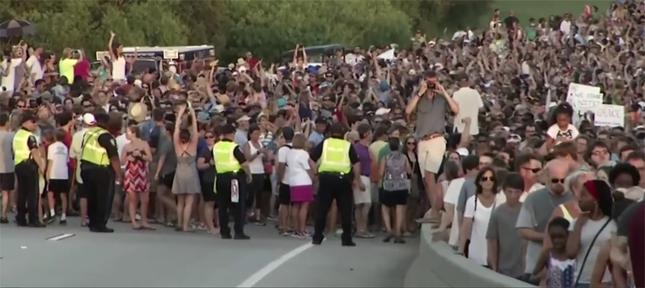Charleston Slayings Stop Time, Blot Out the News, But Bring Us Together
By • June 25, 2015 0 1115

In our daily lives, news cycles never end—something (awful, strange, crazy, violent, awesome) happens and the news goes viral one night, dominates the next day, is analyzed and commented on ad infinitum and slithers away, replaced by the next story, the next piece of oddness, the next disaster, the next next.
Hello Bruce, Good grief, it’s Caitlin, goodbye to both, hello Donald—you know I’m really rich-Trump, (was that Jeb Bush announcing his presidential run?), hello Miss Dolezal, we hardly knew you, but it’s hardly a black or white issue, and you say it is, goodbye Rachel—did you see that no-hitter at Nationals Park?
But sometimes, a story—an event, really—stops everything and a kind of murmuring, shocked stillness ensues in its wake, starting slowly, gaining force, and then, as hours and days pass, and the aftermath itself becomes the event, all the other things—we’ve seen fire and we’ve seen rain—seem to melt away, leaving us at a watershed in time.
That’s what happened last Wednesday, when the news trickled out slowly, out of Charleston, South Carolina, that there had been a shooting at a historically black church that evening, and it evolved to a full blown, shock and ghost-inducing headline: “Nine Dead in Shooting at Black Church in Charleston, S.C.” A similar headline greeting morning coffee drinkers in Charleston itself, its two papers carrying the news, which was unfortunately and horribly and ironically, partially hidden by a sticky ad for a gun shop and shooting range.
The alleged shooter turned out to be a 21-year-old, white high school drop-out named Dylann Roof of Eastover, South Carolina, who was apprehended by local police on Thursday, at least partly due to being identified by relatives. The victims were parishioners at members of a bible study group at Emmanuel AME Church, the South’s oldest African American Church.
Roof, as it turned out, held strong white supremacist views and apparently wrote a manifesto about his beliefs which warned against the country being taken over by blacks and minorities, including Hispanics and Jewish people.
The very deed brought up ghosts that had always haunted this country, where slavery was considered its original sin. They were ghost from slavery days, Jim Crow days, routine lynching in segregation days and nights, the shocking violence done during the high water marks of the Civil Rights movement in the 1960s including a bombing that killed little girls in an Alabama church. It made false the claims that racist times were a thing of the past with the coming of America’s first black president, a notion that had already begun to re-take hold in the wake of a series of fatal police shootings of black men and demonstrations in the wake of incidents that ran from Missouri to New York City to Baltimore, which was struck by anger and fiery demonstrations and looting.
Yet, the shootings—which have been detailed elsewhere and dramatically on television, blotted out the sun and the sum of all other things, including a enormously influential papal encyclical on the environment and income disparity—stopped time itself for a time and left everyone—black and white, everyone with the remarkable effect of seeking solace with each other, not apart, but together.
What else to do in times like that, with the losses so familiar for the victims and their relatives looked and behaved like the kinds of people whose lives we could aspire to, no matter what our skin color?
They embodied decency, generosity of spirit, forgiving natures, they were all about love and family and so it seemed that in South Carolina, where the Confederate Flag—at least, for now—is still allowed to fly freely at the State Capitol, whites, ordinary people and the governor and the senator, and all, flocked to the same church to console each other and be the people which belied the alleged killer’s bigoted and racist claims and embodied the exact opposite.
We think now of that moment in time that this nothing-much person could be welcomed by this group of people, old and young, pastor and retired folks, parents and grandparents and all, look at them for an hour, listen to what they had to say, and commence to shoot because he says he had to.
He could not in the course of an hour, see them at all, for kind hearts, for civil words, for lives they had and lived.
Not at all. He could not image them, let alone see them.
He just commenced to shoot and kill, as if he were just the most important soul under the sun.
He is not.
The nine people whose lives were taken became a loss for everyone who streamed to the church, became a loss for all of us, a huge loss which may yet transform our lives and sense of who we are together and apart.

